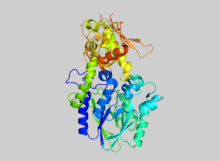5'-nucleotidase
| 5'-nucleotidase | |||||||||
|---|---|---|---|---|---|---|---|---|---|

Human ecto-5'-nucleotidase (CD73): crystal form I (open) in complex with adenosine
|
|||||||||
| Identifiers | |||||||||
| EC number | 3.1.3.5 | ||||||||
| CAS number | 9027-73-0 | ||||||||
| Databases | |||||||||
| IntEnz | IntEnz view | ||||||||
| BRENDA | BRENDA entry | ||||||||
| ExPASy | NiceZyme view | ||||||||
| KEGG | KEGG entry | ||||||||
| MetaCyc | metabolic pathway | ||||||||
| PRIAM | profile | ||||||||
| PDB structures | RCSB PDB PDBe PDBsum | ||||||||
|
|||||||||
| Search | |
|---|---|
| PMC | articles |
| PubMed | articles |
| NCBI | proteins |
5'-nucleotidase (EC 3.1.3.5) is an enzyme which catalyzes the phosphorylytic cleavage of 5'nucleotides. Although originally found in snake venom, the activity of 5'nucleotidase has been described for bacteria and plant cells, and is widely distributed in vertebrate tissue. In mammalian cells the enzyme is predominantly located in the plasma membrane and its primary role is in the conversion of extracellular nucleotides (e.g. 5'-AMP), which are generally impermeable, to the corresponding nucleoside (e.g. adenosine) which can readily enter most cells. Consequently, the enzyme plays a key role in the metabolism of nucleotides.
The enzyme has a wide substrate specificity for nucleotides and has been shown to hydrolyze 5'nucleotides rapidly, ribose-5-phosphate slowly, and other phosphate esters extremely slowly (if at all).
For example, the 5'nucleotidase enzyme catalyses the following chemical reactions
The 5'nucleotidase catalyzed reaction of an AMP nucleotide to adenosine nucleoside is shown below:
Studies of the soluble form of human ecto-5'nucleotidase, without a GPI anchor, have shown that the C-terminal domain holds the substrate-binding pocket, and that the aromatic purine motif of the substrate is stacked between two phenylalanine residues. Furthermore, a catalytic mechanism has been proposed involving an in-line nucleophilic attack by a hydroxyl moiety that is coordinated by zinc on the substrate phosphorus, with the nucleoside acting as a leaving group.
Studies of mammalian 5'nucleotidases have shown that there exist at least four different forms of the 5'nucleotidase enzyme: one membrane-bound form and three soluble forms. The membrane-bound form is anchored to the plasma membrane via GPI at its C-terminus. One of the soluble forms appears to be derived from the GPI-anchored ex-5'-nucleotidase and has an extracellular location. The two cytosolic forms of the enzyme have similar characteristics, but can be differentiated on the basis of their preferential affinities for nucleotide substrates. The GPI-anchored form exists as a dimer, with the two subunits linked via a disulfide bridge. The soluble forms can exist as dimers or tetramers. Generally at least 50% of the enzyme is found in the surface-bound form.
The concentration of 5’nucleotidase protein in the blood is often used as a liver function test in individuals that show signs of liver problems. The combined assays of serum 5'nucleotisase and alkaline phosphatase (AP) activities are extremely helpful in differential diagnosis since serum 5'nucleotidase activity is increased in obstructive hepatobiliary disorders, but not in osseous disorders, whereas serum AP activity is generally increased in both categories of diseases. In other words, the test is used to determine if elevated protein levels are due to skeletal damage or liver damage. Normal levels of 5’nucleotidase are 2-17 units per liter. Elevated levels may indicate cholestasis, destruction of liver cells, hepatitis (liver inflammation), liver ischemia, a liver tumor, or use of liver-damaging drugs. Pregnancy and certain medications (acetaminophen, halothane, isoniazid, methyldopa, nitrofurantoin) may interfere with the test.
...
Wikipedia
